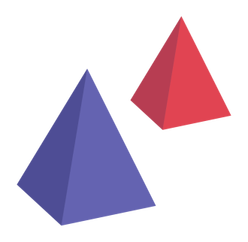E1.3 Identify congruent lengths, angles, and faces of three-dimensional objects by mentally and physically matching them, and determine if the objects are congruent.
Activity 1: Construction of Congruent and Non-Congruent Structures
Have students use nine interlocking cubes to build a "snake".
Examples include:

Invite students to compare their snakes. Ask them to superimpose the edges, angles, and faces of their snake with each other's to find congruent and non-congruent constructions.
Ask them the following questions.
- What do you notice?
- What strategies did you use to locate congruent edges, angles, and faces?
- Which constructions are congruent? not congruent? Explain your reasoning.
Activity 2: Comparison of Two Three-Dimensional Objects
Present the image of the two pyramids below to the students.

Ask them the following questions.
- What do you notice?
- Are the two three-dimensional objects congruent? How do you know? What strategies did you use to reach this conclusion?
- Are there any congruent elements when you compare the two pyramids?
